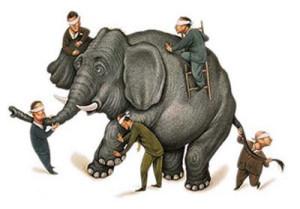
Photo Credit: See this link
At $77 billion --the acquisition value when Aetna’s debt is accounted for in CVS Health’s acquisition of the health insurance company--Aetna and CVS appear set to join forces in the largest acquisition deal of 2017 with CVS Health buying Aetna. At the heart of this deal is the access to CVS's low cost in-store MinuteClinics, but it also means one much bigger stakeholder in place of two at the drug price negotiation table. Interpretations of this deal abound.
What This Deal Means
This question merits a fable: take the story about six blind men who try to understand what an elephant is, and as each man takes hold of a different part of the elephant they come to their own distorted truths: to each respectively the elephant is a broom, a pillar, a hose, and more, depending where each blind person is.
The Aetna/CVS deal is an elephant, with wildly diverse interpretations based on the perspective of the stakeholder.
To Consumers: The Deal Is a Convenience Tool
In CVS and Aetna’s words to the public via CVS’s press release, the reason the PBM and insurance giant joined forces is in the press release title: “Combination to Provide Consumers with a Better Experience, Reduced Costs and Improved Access to Health Care...”
Industry analysts say the acquisition has the potential to make quality of care and access to care more efficient and--theoretically--affordable, depending on the market dynamics where the consumer lives.
To Shareholders: The Deal Is a Cash Cow
In CVS’s words to shareholders, the deal is summed up as “the best value creation opportunity for our shareholders”, with “significant synergy potential of $750M in the 2nd full year.”
The expectation to save $750M in the second full year is based on redundancy (aka layoffs), renegotiating third party contracts, and simplifying distribution channels. CVS also states to shareholders that the care coordination and care managment potential by having easy access to care at MinuteClinics for all of Aetna’s members will contribute to this figure.
To Stakeholders at the Negotiation Table: The New Behemoth Is a Triple Threat
This deal gives consumers a one-stop shop of integrated benefits management and distribution to consumers, which could mean being able to offer these services conveniently and at at a lower price than if consumers got it piecemeal from other companies. It also gives the behemoth more leverage at the negotiation table with drug manufacturers and providers, which means both groups could end up agreeing to taking on risk (e.g. payments tied to quality measures or outcomes) that they otherwise may not have.
To the Industry at Large: It’s an Elephant
As simple as each stakeholder’s definition is, the truth is this deal is many things with potential as far ranging as disrupting the pharmacy benefit manager business model to swinging the tide toward drug/medical benefit coordination for Aetna members while earning a quarter of its revenue from managed care.
It could also mean a quicker transition to value-based contracting, which historically has been pushed onto less willing providers by payers. The insurer/PBM/pharmacy will want providers and pharmaceutical companies to have more skin in the game, even listing value-based contracts as one reason investing in the company will be profitable for shareholders in year 2.
Elephants Are Big But Not Illegal
With about a quarter of the PBM market share and pharmacy market share already under CVS Health, does adding 6% of the insurance market cause antitrust regulators to snap into action? Merger and acquisition analysts agree that federal involvement is possible but is also unlikely. This deal is likely to pass the muster of antitrust laws because it is not monopolizing a regional market with one offering; rather it is integrating various businesses vertically--health plan, PBM, pharmacy--across many regions rather than gaining an anticompetitive market share advantage in any one region. Whereas horizontal integration can reduce competition which often leads to higher prices for consumers, vertical integration has a more diverse track record. However, as reported by The Economist here, “The benefits to consumers of a vertical merger disappear if one of the parties has a monopoly.”
Zoo or Safari?
While hospital mergers and failed health plan mergers and whispers of Amazon pharmacy had the 2017 media waves buzzing with potential changes in a familiar environment, this deal could shake up stakeholder alliances in wild ways. As the industry deepens its understanding of this elephant we could see interesting partnerships and alliances form against the odds.
Wal-Mart, meet Humana?

